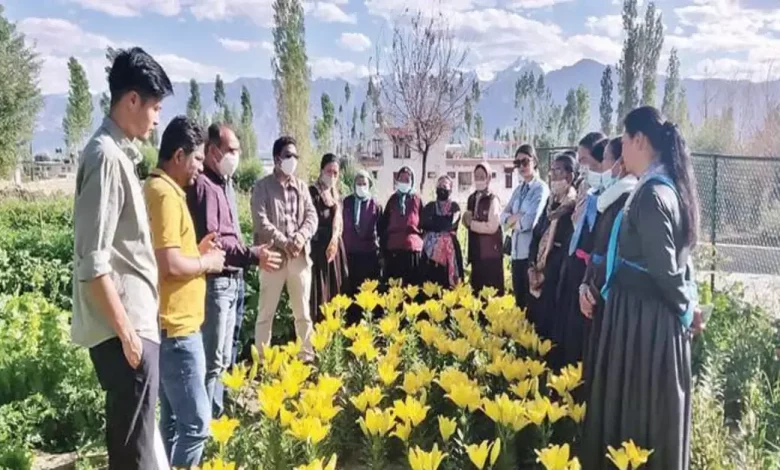
Context- High value aromatic crops and floriculture have emerged as a means to supplement livelihood of Odisha’s tribal communities.
Factors responsible for contamination
- Successful advent of aromatic crops has been seen in Nabarangpur and Koraput districts of Odisha, wherein tribal farmers confirmed an interest in diversifying from the conventional maize crop.
- With the help of the Central Institute of Medicinal and Aromatic Plants (CIMAP) in Lucknow, the district has lately brought different aromatic plants inclusive of,
- menthol mint (the CIM Unnati variety),
- rosemary (Hariyali range),
- patchouli (CIM Samarth),
- damask roses (Ranisahiba),
- chamomile, and
- geraniums (CIM-Bharat).
- The favourable climate and availability of tremendous stretches of land offer thrilling opportunities for farmers to foray into aromatic plantation, even though it’s miles an unusual area.
Central Institute of Medicinal and Aromatic Plants (CIMAP)
- Established in: 1957
- It is a multidisciplinary studies institute of Council of Scientific and Industrial Research (CSIR), India with its essential focus on exploiting the capacity of medicinal and aromatic flora (MAPs).
- Headquarters: Lucknow and research facilities at Bengaluru, Hyderabad, Pantnagar, and Purara,
- CSIR-CIMAP homes a National Gene Bank on MAPs.
- Mandate: Engage in multi-disciplinary tremendous research in agricultural, biological and chemical sciences and lengthening technologies and offerings to the growers and marketers of MAPs.
About aromatic plants:
- Aromatic plants contain fragrant compounds, that are basically critical oils.
- These important oils are odorous, risky at room temperature, hydrophobic and ighly concentrated compounds.
- They can be acquired from plants, buds, seeds, leaves, twigs, bark, timber, fruits and roots.
- Aromatic plant life does not face regulatory challenges medicinal plantations face.
- There is a huge call for aromatic plants within the marketplace because of their diversified uses.
- Examples: Lemongrass, Mentha, Vetiver, Citronella, and so forth.
Uses:
- Culinary herbs: Basil, rosemary, thyme, and mint are culinary staples, adding taste and aroma to dishes.
- Spices: Cumin, cloves, and superstar anise enrich our palates with their powerful scents and flavor.
- Medicinal plants: Lavender, chamomile, and valerian root are acknowledged for their calming and healing properties.
- Cosmetics and perfumes: Rose, jasmine, and sandalwood vital oils are prized for their captivating fragrances in perfumes and splendor products.
- Aromatherapy: Essential oils from plants like eucalyptus and lemongrass may be used for inhalation or massage to sell relaxation and properly-being.
- Insect repellents: Citronella and lemongrass oils offer herbal alternatives to artificial insect repellents.
- The distinct odour of lemongrass, citronella and vetiver, also repels elephants.
- Landscaping and gardening: Ornamental flowers like fragrant roses, lilies, and lavender add beauty and fragrance to gardens and out of doors areas.
About the Aroma Mission:
- CSIR’s Aroma Mission pursuits to increase the income of the farmers through cultivation of high cost and high demand aromatic crops by using about Rs. 30,000 to 60,000/ha/12 months.
- On 4th June, 2023 CSIR-Indian Institute of Integrative Medicine, Jammu released the third phase of CSIR-Aroma Mission at some stage in the Lavender Festival carried out at Bhaderwah of Jammu & Kashmir, UT.
- It additionally aims to carry an extra place of 30,000 hectares under cultivation of those vegetation to further catalyze the cultivation of aromatic plants in approximately 60,000 hectares.
- This will assist in production of an additional seven-hundred tonnes of important oil for perfumery, cosmetics and pharmaceutical industries, and use of these oils in price addition and herbal merchandise could generate a business of at least two hundred crores.
- About 45e,000 professional human assets capable of multiplying first-rate planting fabric, distillation, fractionation and price addition can also be advanced underneath “Skill India” tasks.
- More than 25,000 farming households could be directly benefited and an employment of more than 10-15 lakhs mandays could be generated in rural regions.
- Scientific interventions would provide confident advantages to the growers of Vidarbha, Bundelkhand, Gujarat, Marathwada, Rajasthan, Andhra Pradesh, Odisha and different states wherein farmers are uncovered to common episodes of climate extremes and account for optimum suicides.
Source: The Hindu





.png)



